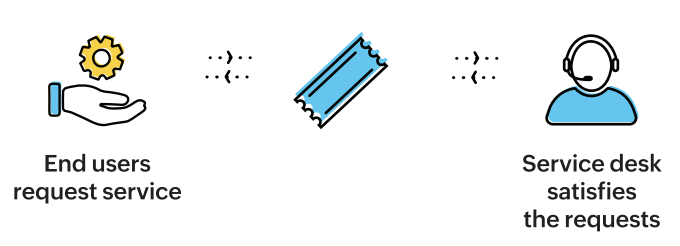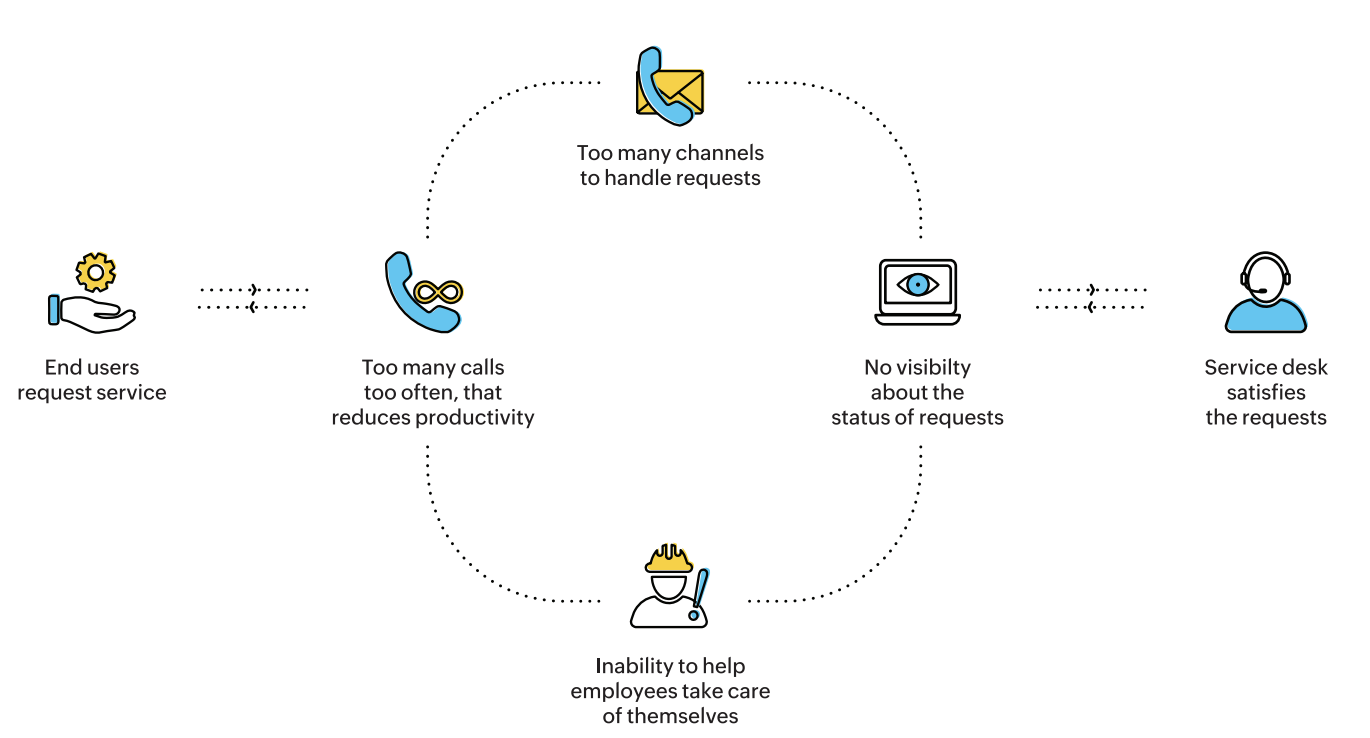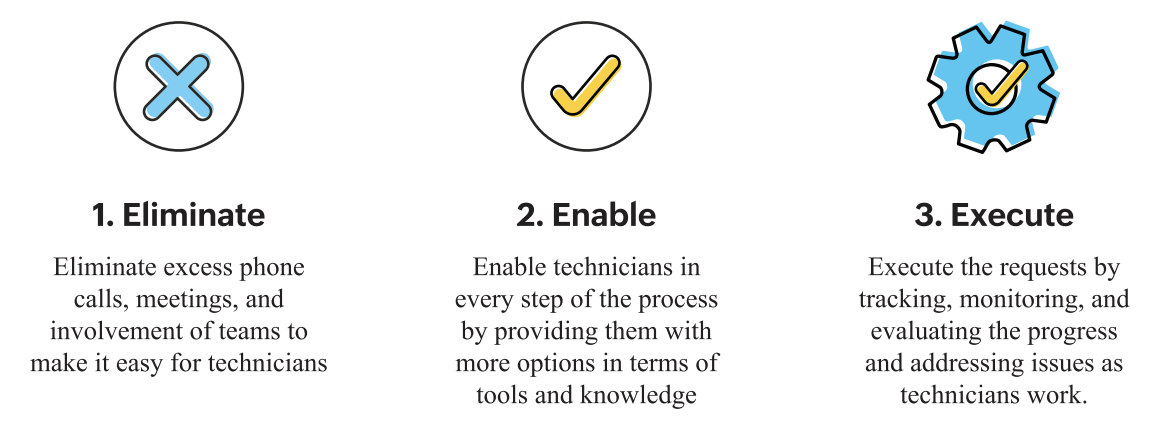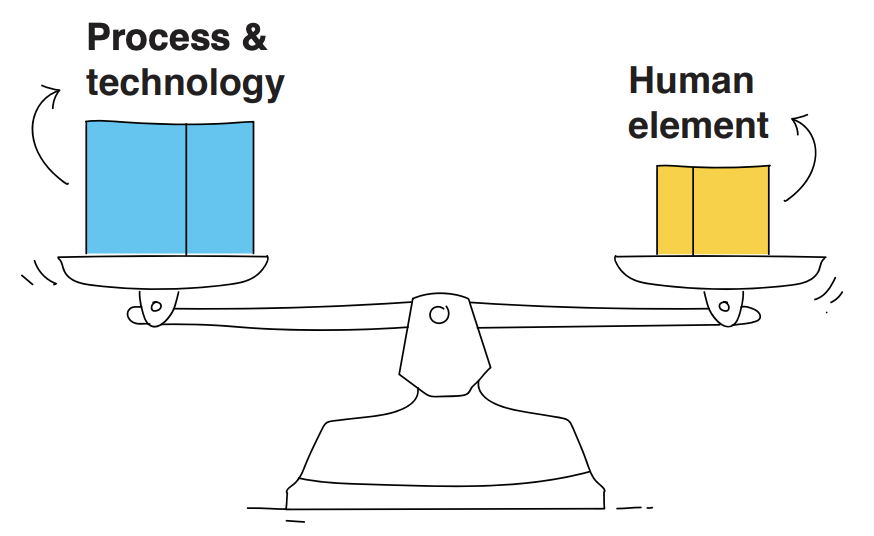How Zoho's IT turns every service request into a pleasant experience
The untold story of our employee experience
Why you should read this book?
The correlation is real.
Happy employees = happy customers
It's a no-brainer that people have the power to shape and transform businesses. For modern enterprises, a people-centric approach to processes is a must-have, as it helps them know what their workforce wants and solve their day-to-day requests so they can be most productive.
We could not agree more with Jason Jennings, reputed researcher, speaker, and author of eight New York Times best sellers, as he rightly puts it, "The only differentiator for any corporate in the world is its people, and not the niche it plays in, not the market it focuses, not the valuation it commands, and not the revenues it clocks in."
At Zoho, we believe our people-centric culture has fueled our transformation from a 200-strong start-up in the 90s (AdventNet Inc.) to a modern-day enterprise with a workforce of 8,000 and more than 50 million users worldwide.
Throughout this 23-year-long IT service journey, our approach of treating employees as our first customers has acted as a buffer to the daily grind that employees go through at work, and this in turn has had a dramatic effect on our customers' experience.
So, how do we do it? Is it our belief in the strong, undeniable connection between employee and customer experience; the technology we use; or our process maturity? How do we connect with our people and grow them from inside out? This e-book says it all!
What’s inside?
- Our journey in IT service delivery—the best methods to deliver a great service experience
- Our processes beyond IT that saw an uptick in employee productivity and morale across departments
- Insights for IT leaders to understand and manage the complex relationship between IT and business
- Comprehensive case studies based on Zoho's internal IT service request scenarios

The challenges ahead
When we began business in the late 90s, the company had few employees and just two system administrators working in shifts. The sysadmins (a term we use to refer to the technicians at Zoho) used a common server to simply gather all requests, ranging from a minor password reset to a major change in the network.
If a request was unresolved before the end of a shift, the sysadmins verbally communicated the necessary information to each other. And if that was not an option, they used Yahoo Messenger. That system worked for a time. However, as our business grew, the volume and complexity of the service requests increased greatly, which meant we needed a new system.
We then released the first version of our internal service desk system, ServiceDesk Plus, and our sysadmins started to get familiarized with the new system. We also increased the strength of the Sysadmin team to ensure tickets were resolved on time.
We expected this new system to set up our sysadmins to provide seamless internal support. Here's what we envisioned:

However, the reality was different. There was a vicious cycle of inefficiencies always in play, and the result was hardly a pleasant experience! Requests were fulfilled, but we also had shortcomings hiding in plain sight affecting the overall service experience.
We had our work cut out for us, with some major challenges lying ahead:
- The unlimited types: The variety of service requests we handle in a day can be quite remarkable—requests for application access, software licenses, password resets, new hardware, and so much more. And each of these categories often have multiple subcategories.
- Communication: With so many different types of requests, lack of communication led to even more problems. What started with Yahoo Messenger (or even verbal communication) in the 90s has now grown and been refined into support desks, chatbots, and in-house apps. But during each stage of expansion and the resulting increase in types of requests, number of sysadmins, and the size of the organization, communication was always a challenge.
- The fulfillment part: With so many variables at play, more than one sysadmin may be required to fulfill a request. How they communicate with employees is one thing, but how they coordinate within themselves and fulfill each request is a different story.
- Too many channels: For a typical new hire request, the number of touch points for the customer to log on, and the channels needed to fulfill the request, can be overwhelming. What is an efficient, semi-automated system now was once a place for inefficiencies due to multiple channels.
- The confused employee: The employee (end user) is the simplest element of the service request life cycle, but the reality is often far from that. Lack of unified employee information, poor visibility, and delayed notifications on the status of requests ensured service requests weren't simple enough for employees either.
- A platform for knowledge Can employees get answers fast and evaluate their requests before reaching the service desk? Creating, managing, and maintaining such a knowledge base was a major challenge.
- Measuring progress How can a sysadmin know if the service delivery performance is good enough? How do they know which stage of the request is taking too much time? Can a sysadmin instantly check how many requests are completed satisfactorily within agreed service-level agreements (SLAs)? What can be measured can be improved, and measuring the important metrics like time to resolution, time to close, customer satisfaction, and pending requests was a big challenge.
- Too many departments A typical travel request required multiple departments and teams across the company at every stage—like the Travel Desk, HR, the Accounts Department, and other vendors. Was there a system to integrate all these diverse functionalities to ensure every travel request was successfully and satisfactorily served? That was a challenge.

These challenges meant it was tough for a request to be fulfilled satisfactorily. Though we got the job done, there was a long way to go before we could offer employees a quality experience. If they remained unsatisfied, it could affect their mental state and motivation to work on their tasks.
Our journey towards a great employee experience goes way beyond remunerations; we always wanted employees to have the best possible experience with their requests so they could focus wholeheartedly on work without being bothered with other difficulties. To move towards this goal, we had to deal with these challenges.
These challenges can be grouped in terms of the concerned parties in the service request life cycle:
Challenge |
Concerned party |
|
Access all available services with ease |
Employee (end users) |
|
Use a service or access information about services quickly |
|
|
Gain transparency on how services are delivered |
|
|
Communicate all services provided to end users |
Sysadmin (service providers) |
|
Provide services promptly |
|
|
Ensure end-user satisfaction |
After simplifying and categorizing these challenges, it was time to solve them. We started by establishing a framework to build on, a platform that would ensure any improvement would always focus on the core problem of addressing these challenges and providing a great experience.
We slowly grew into the enterprise we are today, and we were able to establish a system—a synergy of tools, interconnected processes, and platforms to create custom solutions. This system today has also grown roots and expanded into data center compliance, well-established process control, and high-level automation to serve employee requests. But the framework on which all this is built has always been the key to our success.
A framework for experience
This framework revolves around finding solutions and establishing a system that will focus on continually improving the service request experience for the end user.
What are the components of this framework?
-
The service catalog
Identify and create the list of services that are aligned with your business. Next, showcase that list to end users so they can raise requests.
-
A service hub
Establish a central location for raising requests related to the services with the help of a service desk.
-
Central, streamlined workplace
Take a holistic approach to manage and deliver those requests by bringing together IT and non-IT teams like HR, payroll, facilities, and legal services. In other words, designate a single point of contact for all enterprise requests.
-
A focus on automation
Have automation in place at every step of resolving employee requests to ensure speedy resolution.
-
Integrations
Integrate technologies that can play together while handling service requests.
-
SLAs
Manage the expectations of end users with SLAs and ensure timely delivery for end-user satisfaction.
-
Data management
Effectively collect information to process service requests.
-
Knowledge base
Set up a system where end users can gain knowledge before approaching the service desk.
-
Continual improvement
Review the efficiency of the service desk for continual improvement.
This framework acts as a guiding rule book with which we design our processes. It has helped shape our processes to provide the best possible service experience. Such a framework is also crucial to turn any service request program into a well-oiled machine that can be guided with little external intervention.
To implement this framework, we needed principles to guide us during every step of the journey. These principles ensure that any confusion that might arise while implementing the framework can be handled effectively.
We call these principles the three Es.
The three Es of experience
Our efforts to create the best employee experience began with our sysadmins providing employees with better streamlined processes and a conducive environment by following the three Es principle.

These principles can work for any organization, no matter the size, and can set the foundation for creating the service request management framework.
In further sections, we will see how the framework and the three Es helped us crack the code in terms of employee satisfaction. We'll also give you a sneak peek at processes that will guide you in turning your organization's service requests into a pleasant experience.
If you take a closer look at the framework and the three Es, you'll notice that they are an effective combination of automation and human principles. This is where you need to understand our mindset—the one that has driven our actions over two decades.
The mindset that mattered
Long past the time when sysadmins could identify each employee by name and verbally address their service requests, we needed a service desk to gather requests. So, we created our in-house service desk software.
That has been our mantra and the mindset of our leaders. We solve our problems, then we offer the solution to the world.
The service desk then acted as a hub for all kinds of requests. Sysadmins could pick and choose their tickets and track them to closure. However, as we grew bigger and our portfolio of requests widened, we faced complexities.
Our sysadmins have always been highly capable, willing to learn to serve all requests and solve any problem. The highly equipped team also shared camaraderie with employees, which meant the going was smooth. However, each sysadmin had their own way of handling things. Though this was often a good thing, it compromised on standardization, which was crucial when the process became lengthy and complicated.

Somewhere, we had to strike a balance between a framework approach, where processes drive requests, and individual freedom, where things can be handled differently. As we will see in further sections, each request involves a huge number of processes. However, at times, the sysadmin takes over and adds their own flavor, which turns the request into a pleasant experience. Even if it is only a few instances, the human element is equally important.
In every service request scenario in this book, we will see how the processes in place and the human element of sysadmins coexist to create a good experience.
A quick recap: With a mindset to strike a balance between technology and human intervention, and the three Es to create a working framework for sysadmins, we were equipped to achieve the service request paradigm. However, there was still a missing element: the element of indication.
The subtle indicators
Values are like fingerprints. Nobodies are the same but you leave them all over everything you do.
We have numerous diverse examples (service requests) flowing in all day, as one would expect. However, in spite of their variations, we can see similarities in the level of effort we take to satisfy requests.We can correspondingly group them into similar kinds of service requests.
In our case, we have four such groups of service requests. Each group is like a scenario, which will tell a story of how we overcame inefficiencies, applied our principles, and executed the service request program:
 Minimalism
Minimalism
We do no more than what is necessary. Minimalism ensures that all redundancies, non-value-added activities, and extras are eliminated from the process.
 Effectiveness
Effectiveness
Achieve the objectives no matter what and ensure all aspects of the service request are completed fully. It is often easy to get consumed by efficiency (how well or how fast you can complete a request) and fail at completing every request fully. A half complete request can tarnish the experience.
 Clarity
Clarity
We ensure that the employees and teams serving requests have complete clarity on the life cycle of a request, as confusion can lead to added tasks, unreliable data sources, and obsolete processes.
In the following sections of this e-book, we will talk about how these values guided and reshaped our service request management process.
Service request scenarios
Without continual growth and progress, such words as improvement, achievement, and success have no meaning.
We had the right mindset, a conducive environment, and highly skilled sysadmins to create and accelerate the service request process. However, was it enough? How do we know if our approach is comprehensive and truly working to deliver a pleasant experience to our employees every time?
We use the underlying values to guide us through that process. These values are subtle indicators that our methods are well-positioned to deliver what they should. At every juncture, these indicators show us what the end objective must feel like. Just like how we had the three Es for sysadmins, these three indicators must always be part of our process:
-
The everyday story
The familiar story of things like password resets and hardware and software asset requests.
-
New hire request
The elaborate story of succeeding at employee onboarding.
-
Travel requests
The tricky story of simplifying and nailing the travel request scenario.
-
The story of Jeeves
The satisfying story of Jeeves, a service request machine that serves requests almost every minute.
Each section in this book will deal with one such scenario by narrating the story of our experience. These scenarios might vary in nature and magnitude for your organization, but the underlying principles will remain the same.
-
Previous Chapter
‹ - ›